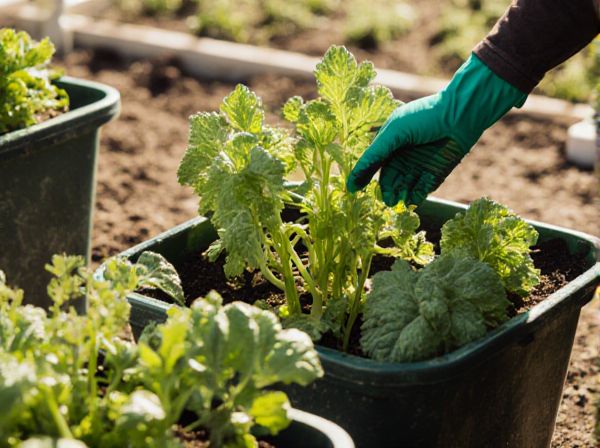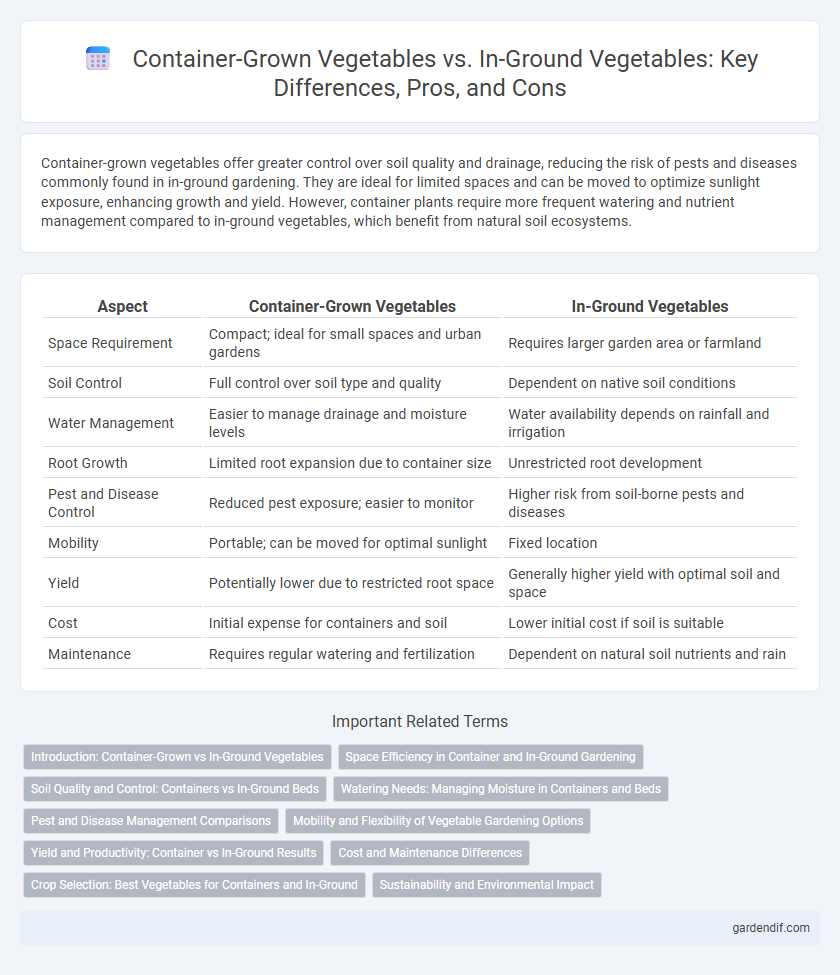
Container-grown vegetables vs in-ground vegetables Illustration
Container-grown vegetables offer greater control over soil quality and drainage, reducing the risk of pests and diseases commonly found in in-ground gardening. They are ideal for limited spaces and can be moved to optimize sunlight exposure, enhancing growth and yield. However, container plants require more frequent watering and nutrient management compared to in-ground vegetables, which benefit from natural soil ecosystems.
Table of Comparison
| Aspect | Container-Grown Vegetables | In-Ground Vegetables |
|---|---|---|
| Space Requirement | Compact; ideal for small spaces and urban gardens | Requires larger garden area or farmland |
| Soil Control | Full control over soil type and quality | Dependent on native soil conditions |
| Water Management | Easier to manage drainage and moisture levels | Water availability depends on rainfall and irrigation |
| Root Growth | Limited root expansion due to container size | Unrestricted root development |
| Pest and Disease Control | Reduced pest exposure; easier to monitor | Higher risk from soil-borne pests and diseases |
| Mobility | Portable; can be moved for optimal sunlight | Fixed location |
| Yield | Potentially lower due to restricted root space | Generally higher yield with optimal soil and space |
| Cost | Initial expense for containers and soil | Lower initial cost if soil is suitable |
| Maintenance | Requires regular watering and fertilization | Dependent on natural soil nutrients and rain |
Introduction: Container-Grown vs In-Ground Vegetables
Container-grown vegetables offer a controlled environment that enhances soil quality and moisture retention, promoting healthier plant growth compared to traditional in-ground vegetables. These containers allow for better pest management and flexibility in space usage, especially in urban settings or areas with poor soil conditions. In-ground vegetables rely on natural soil ecosystems, which can provide diverse nutrients but may face challenges like soil-borne diseases and inconsistent water availability.
Space Efficiency in Container and In-Ground Gardening
Container-grown vegetables maximize space efficiency by allowing gardeners to cultivate plants in compact, vertical, or non-traditional areas such as balconies, patios, and rooftops. In-ground gardening requires larger, dedicated plots of land, often limiting the number and variety of vegetables due to spacing needs and soil quality constraints. Containers enable better utilization of small spaces with tailored soil conditions, promoting higher density planting and yield per square foot compared to traditional in-ground methods.
Soil Quality and Control: Containers vs In-Ground Beds
Container-grown vegetables offer superior soil quality control by allowing gardeners to customize nutrient levels, pH balance, and drainage precisely, unlike in-ground beds where soil composition varies widely and is harder to amend. Containers reduce the risk of soil-borne diseases and pests often found in traditional garden soil, enhancing plant health and yield consistency. These factors make container gardening an ideal choice for optimizing growing conditions in limited or compromised soil environments.
Watering Needs: Managing Moisture in Containers and Beds
Container-grown vegetables require more frequent watering due to limited soil volume, which dries out faster than in-ground beds with natural moisture retention. Maintaining consistent moisture in containers involves monitoring daily water levels and ensuring proper drainage to prevent root rot. In contrast, in-ground vegetables benefit from deeper soil that holds water longer, reducing the frequency of irrigation and promoting healthier root development.
Pest and Disease Management Comparisons
Container-grown vegetables benefit from improved pest and disease management due to controlled soil conditions and reduced exposure to ground-borne pathogens, leading to fewer infestations of common pests such as root nematodes and soil fungi. In-ground vegetables often face higher risks from soil-dwelling pests like wireworms, cutworms, and various fungal diseases caused by continuous crop rotation challenges and less controlled soil environments. Using sterile potting mixes in containers minimizes disease transmission, while in-ground cultivation requires more frequent use of crop rotation, soil amendments, and chemical treatments to mitigate pest and disease pressures effectively.
Mobility and Flexibility of Vegetable Gardening Options
Container-grown vegetables offer superior mobility and flexibility compared to in-ground gardening by allowing easy relocation to optimize sunlight exposure or protect from harsh weather. These portable containers enable urban gardeners to maximize limited space on patios, balconies, or rooftops without permanent soil modification. This adaptability supports diverse planting schedules and crop rotation, enhancing overall garden productivity.
Yield and Productivity: Container vs In-Ground Results
Container-grown vegetables often exhibit faster growth rates due to controlled soil conditions, resulting in higher yield per square foot compared to in-ground cultivation. In-ground vegetables may produce larger fruits or root systems but typically require more space and are more susceptible to environmental stressors, which can reduce overall productivity. Studies show container gardening maximizes yield efficiency, especially in limited spaces, by optimizing moisture and nutrient availability.
Cost and Maintenance Differences
Container-grown vegetables often require higher initial investment due to the cost of pots, soil, and fertilizers, but they can reduce long-term maintenance costs by minimizing weed growth and soil pests. In-ground vegetables typically have lower startup costs as they utilize existing soil but demand more frequent weeding, soil amendment, and pest control, increasing labor over time. Water usage tends to be more efficient in containers with targeted irrigation, while in-ground plants may need broader watering efforts, impacting overall maintenance expenses.
Crop Selection: Best Vegetables for Containers and In-Ground
Tomatoes, peppers, and lettuce thrive in container gardening due to their compact root systems and controlled soil requirements, while root vegetables like carrots and potatoes perform better in in-ground beds where deeper soil promotes growth. Container-grown herbs such as basil and parsley adapt well to limited space and consistent moisture levels. In-ground cultivation suits larger, nutrient-demanding crops like squash and corn, which require ample space and robust soil ecosystems for optimal yield.
Sustainability and Environmental Impact
Container-grown vegetables reduce soil erosion and minimize water runoff compared to in-ground cultivation, enhancing sustainability by conserving local ecosystems. Using recycled or biodegradable containers decreases plastic waste and lowers the carbon footprint associated with traditional farming methods. Controlled environments in containers also reduce the need for pesticides and fertilizers, limiting harmful chemical runoff into surrounding soil and waterways.
Container-grown vegetables vs in-ground vegetables Infographic

 gardendif.com
gardendif.com